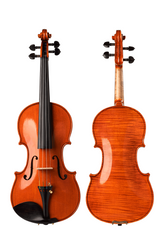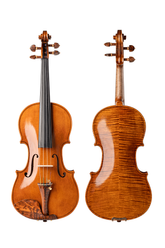Understanding Rosin: Violin, Viola, Cello, and Double Bass
Rosin, a crucial accessory for string players, serves as the link between the bow and the strings, enabling the bow to grip and produce sound.
While rosins for violin, viola, cello, and double bass share fundamental properties, each has unique characteristics tailored to the instrument’s needs.
This article explores the similarities, differences, and interchangeability of these rosins.
Similarities Among Rosins
- Core Material All rosins are made from tree sap, typically pine or similar resinous trees. The resin is purified and sometimes blended with additives to achieve desired properties.
- Functionality Regardless of the instrument, rosin's primary role is to create friction between the bow hair and the strings, facilitating sound production.
- Packaging and Appearance Rosin usually comes in a cake form, sometimes mounted on a cloth or in a protective case, and ranges in color from light amber to dark brown.
- Categories Rosin can be broadly categorized into light and dark varieties, with light rosin being harder and less sticky, and dark rosin being softer and more adhesive.
Differences Between Instrument-Specific Rosins
-
Hardness and Adhesion
- Violin and Viola Rosin: Generally harder with less grip, suitable for higher-pitched strings that require finer control and less resistance.
- Cello Rosin: Softer than violin and viola rosin, providing a stronger grip to accommodate the thicker strings of the cello.
- Double Bass Rosin: The softest and stickiest, designed to handle the deep, resonant strings of the double bass.
-
Additives
- Rosins for lower-pitched instruments often include more additives, such as metal powders (e.g., gold, silver, or copper), to enhance grip and tonal richness.
-
Dust Levels
- Violin and viola rosins tend to produce more dust, while cello and bass rosins are formulated to minimize dust due to their stickier nature.
-
Climate Sensitivity
- Softer rosins (dark varieties) are more sensitive to temperature and humidity changes, making them more suitable for colder climates. Harder rosins are better for warmer environments.
Can Rosins Be Shared Across Instruments?
Sharing rosin between instruments is possible but not ideal. Here’s why:
-
Violin and Viola
- These instruments share similar string tensions and bowing techniques, making their rosins more interchangeable.
-
Cello and Double Bass
- Cello rosin can sometimes work for double bass, especially in pinch situations, but bass rosin is generally too sticky for cello use.
-
Across Pitch Families
- Using a violin rosin on a cello or bass would likely result in insufficient grip, while a cello or bass rosin on a violin may make the bow excessively sticky, reducing playability and precision.
-
Tone and Playability
- Each rosin is formulated to enhance the tonal characteristics of its intended instrument. Cross-usage can compromise tone quality and playing ease.
Recommendations for Optimal Use
-
Match Rosin to Your Instrument
- Choose rosin designed specifically for your instrument to ensure optimal performance and sound quality.
-
Consider Your Playing Environment
- Use lighter rosins in hot climates and darker rosins in cooler climates to maintain consistent performance.
-
Experiment Within Categories
- Try different brands and formulations within your instrument’s category to find a rosin that best suits your playing style and tone preference.
Conclusion
While the fundamental purpose of rosin remains consistent across string instruments, the specific formulations for violin, viola, cello, and double bass address their unique requirements. Sharing rosin across instruments is possible but often leads to suboptimal results. For the best playing experience, invest in high-quality rosin tailored to your instrument and personal needs.






